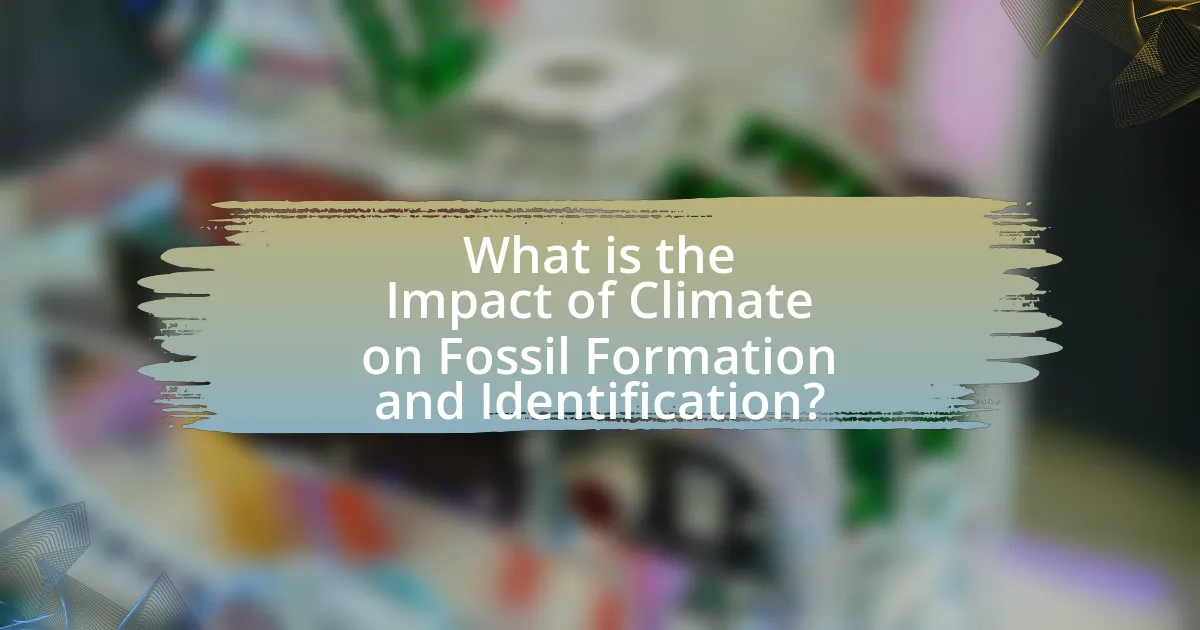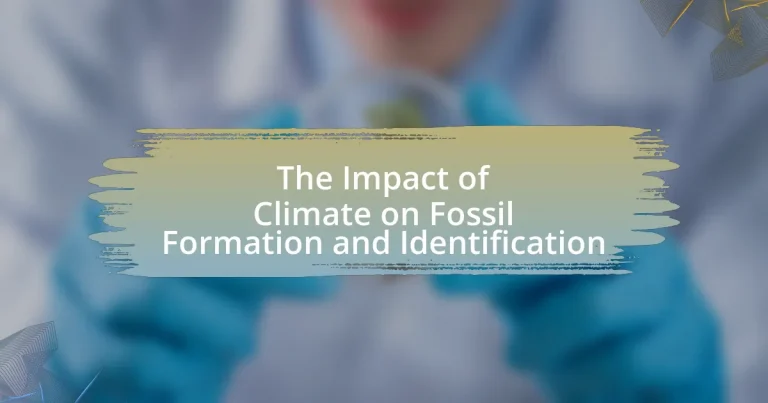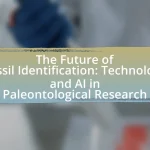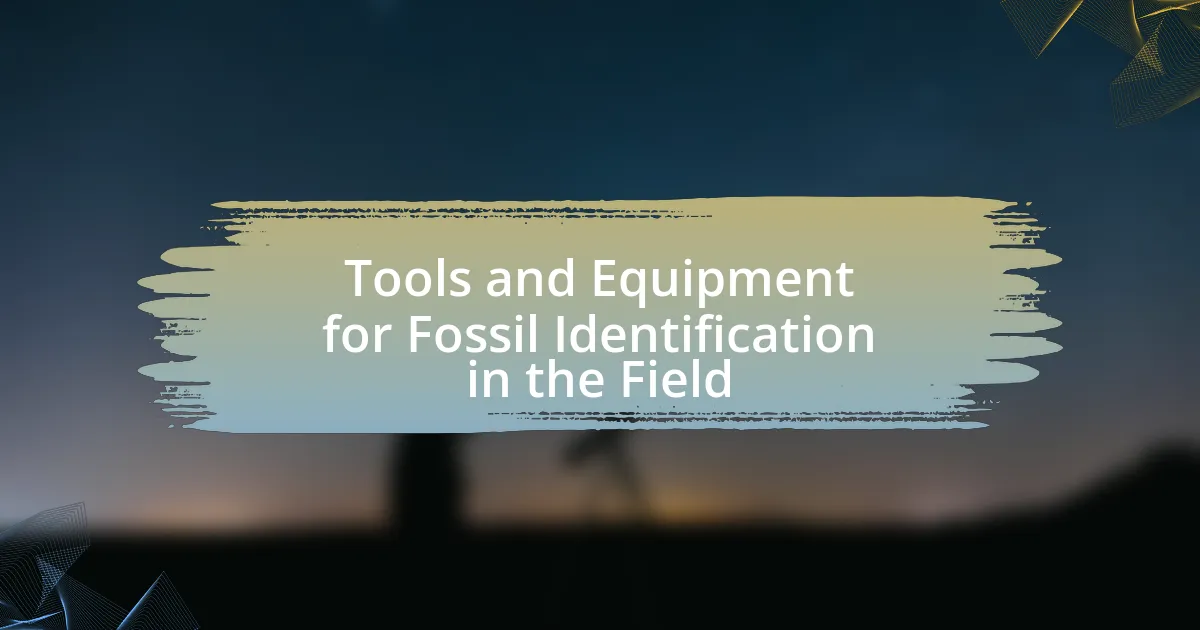The article examines the significant impact of climate on fossil formation and identification, highlighting how various climatic factors such as temperature, precipitation, and oxygen levels influence the preservation of organic materials. It discusses the fossilization process, emphasizing that warmer and wetter climates can accelerate decomposition, while arid conditions enhance preservation. Additionally, the article explores the relationship between climate change and fossil records, illustrating how shifts in climate correlate with species distribution and diversity. Key methods for fossil identification, including isotopic analysis and stratigraphic correlation, are also addressed, underscoring the importance of understanding climate in paleontological research.

What is the Impact of Climate on Fossil Formation and Identification?
Climate significantly influences fossil formation and identification by affecting the conditions under which organisms are preserved and the geological processes involved. For instance, warmer and wetter climates promote rapid decomposition, reducing the likelihood of fossilization, while arid conditions can enhance preservation by limiting decay. Additionally, climate impacts sedimentation rates and the types of sediments deposited, which are crucial for fossil preservation. Research indicates that during periods of climate change, such as the Paleocene-Eocene Thermal Maximum, fossil records show shifts in species distribution and diversity, aiding in the identification of past climates and environments. Thus, understanding climate’s role is essential for interpreting the fossil record accurately.
How does climate influence the fossilization process?
Climate significantly influences the fossilization process by affecting the conditions under which organic materials are preserved. For instance, warmer and wetter climates can accelerate decomposition, reducing the likelihood of fossilization, while arid conditions can promote preservation by limiting decay. Additionally, sedimentation rates, which are influenced by climate, play a crucial role; rapid sediment deposition in flood-prone areas can bury remains quickly, enhancing fossilization chances. Studies indicate that fossilization is more prevalent in environments with stable temperatures and low oxygen levels, as these conditions minimize biological activity that would otherwise lead to decay.
What are the key climatic factors affecting fossil formation?
The key climatic factors affecting fossil formation include temperature, precipitation, and the presence of oxygen. Temperature influences the rate of decomposition and mineralization, with warmer conditions generally accelerating these processes. Precipitation affects sedimentation rates and the burial of organic material, which is crucial for fossilization. The presence of oxygen determines the type of decay that occurs; anaerobic conditions are more favorable for fossil preservation as they slow down decomposition. These factors collectively influence the likelihood and quality of fossil formation in various environments.
How do temperature and precipitation impact fossil preservation?
Temperature and precipitation significantly influence fossil preservation by affecting the conditions under which organic materials are buried and mineralized. High temperatures can accelerate decomposition, reducing the likelihood of fossilization, while moderate temperatures can enhance preservation by slowing decay processes. Additionally, precipitation levels determine sedimentation rates; excessive rainfall can lead to erosion, while optimal moisture levels promote the accumulation of sediments that protect remains. Research indicates that environments with stable temperatures and consistent precipitation, such as river deltas or lake beds, are more conducive to fossil preservation, as evidenced by numerous fossil finds in these settings.
Why is understanding climate important for paleontology?
Understanding climate is crucial for paleontology because it influences the conditions under which fossils are formed and preserved. Climate affects sedimentation rates, erosion, and the types of organisms that can thrive in a given environment, all of which are essential for fossilization processes. For instance, warmer, wetter climates typically enhance organic matter decomposition, while arid conditions may lead to better fossil preservation due to reduced decay. Additionally, paleontologists use climate data to reconstruct ancient ecosystems and understand species distribution, as evidenced by studies showing correlations between climate shifts and mass extinction events, such as the end-Permian extinction, where drastic climate changes contributed to the loss of approximately 90% of marine species.
How does climate change affect the fossil record?
Climate change significantly affects the fossil record by altering environmental conditions that influence fossilization processes. Changes in temperature, sea level, and precipitation can lead to shifts in sedimentation rates and the types of organisms that are preserved. For instance, warmer temperatures can increase the rate of decomposition, reducing the likelihood of fossil formation. Additionally, rising sea levels can inundate coastal areas, leading to the loss of habitats and the organisms that inhabit them, thereby decreasing the diversity of fossils available for study. Research indicates that periods of rapid climate change correlate with mass extinction events, which are reflected in the fossil record, demonstrating the direct impact of climate on the types and quantities of fossils that are preserved.
What role does climate play in the distribution of fossils?
Climate significantly influences the distribution of fossils by affecting the environmental conditions necessary for fossilization and the types of organisms that can thrive in specific climates. For instance, warmer and wetter climates tend to promote the preservation of organic material, leading to a higher likelihood of fossil formation in these regions. Conversely, arid climates may limit the types of organisms that can be preserved due to rapid decomposition and erosion. Additionally, geological processes influenced by climate, such as sedimentation rates and erosion patterns, further dictate where fossils can be found. Evidence from paleontological studies indicates that fossil-rich deposits are often located in areas that were once conducive to life under specific climatic conditions, such as ancient riverbeds or lakebeds in tropical regions.

What are the different types of fossils influenced by climate?
The different types of fossils influenced by climate include permafrost fossils, amber fossils, and sedimentary fossils. Permafrost fossils, such as mammoths and other Ice Age species, are preserved in frozen ground, showcasing how cold climates can lead to exceptional preservation. Amber fossils, formed from tree resin in warm, humid environments, often contain insects and plant material, illustrating the biodiversity of tropical climates. Sedimentary fossils, which can include a variety of organisms, are influenced by climate through the types of sediments deposited in different environments, such as river deltas or ocean floors, reflecting the climate conditions at the time of deposition. These fossil types provide insight into past climates and ecosystems, demonstrating the direct relationship between climate and fossil preservation.
How do environmental conditions shape fossil types?
Environmental conditions significantly shape fossil types by influencing the processes of fossilization and the types of organisms that can be preserved. For instance, sedimentary environments such as river deltas or ocean floors provide the necessary conditions for the burial and preservation of organic material, leading to the formation of fossils. Additionally, factors like temperature, moisture, and the presence of oxygen affect decomposition rates and mineralization processes, which in turn determine the fossil’s characteristics. For example, in anoxic environments, where oxygen is limited, soft tissues are more likely to be preserved, resulting in fossils that retain more detail compared to those formed in oxygen-rich conditions where decay is rapid. This relationship between environmental conditions and fossil types is supported by paleontological studies that show variations in fossil preservation across different geological settings, highlighting how specific conditions favor certain types of fossils over others.
What are the differences between body fossils and trace fossils?
Body fossils and trace fossils differ primarily in what they represent; body fossils are the preserved remains of the actual organism, such as bones, teeth, or shells, while trace fossils are indirect evidence of an organism’s activity, such as footprints, burrows, or feces. Body fossils provide direct insight into the physical characteristics of the organism, whereas trace fossils offer information about the behavior and interactions of organisms with their environment. For example, a dinosaur bone found in sedimentary rock is a body fossil, while a set of dinosaur footprints in the same rock layer is a trace fossil. This distinction is crucial for paleontologists in reconstructing past ecosystems and understanding the impact of climate on fossil formation and identification.
How does climate affect the formation of specific fossil types?
Climate significantly influences the formation of specific fossil types by determining the environmental conditions under which organisms are preserved. For instance, warm and humid climates promote the rapid decomposition of organic material, making fossilization less likely, while arid or cold climates can enhance preservation by slowing decay processes. Additionally, sedimentation rates, which are affected by climate, play a crucial role; in regions with high rainfall, increased sediment can bury remains quickly, leading to fossilization. Research indicates that fossil types such as amber, which forms from tree resin in warm climates, and permafrost-preserved mammoths in cold climates, exemplify how climate directly impacts fossilization processes.
What are the implications of fossil types for climate studies?
Fossil types significantly influence climate studies by providing insights into past environmental conditions and climate changes. Different fossil types, such as plant remains, marine organisms, and terrestrial animals, serve as indicators of specific climatic conditions during the time of their existence. For instance, the presence of certain plant fossils can suggest a warm, humid climate, while marine fossils may indicate sea level changes and ocean temperatures. Research has shown that isotopic analysis of fossilized remains can reveal temperature variations over geological time scales, thus allowing scientists to reconstruct ancient climates. This information is crucial for understanding the relationship between climate and biodiversity, as well as predicting future climate scenarios based on historical data.
How can fossils indicate past climate conditions?
Fossils can indicate past climate conditions by preserving evidence of the organisms that lived in specific environments, which reflect the climate at that time. For example, the presence of certain plant fossils, such as ferns, suggests a warm and humid climate, while the discovery of polar dinosaur fossils indicates a once warmer climate in those regions. Additionally, isotopic analysis of fossilized remains can provide insights into temperature and precipitation patterns. Studies have shown that the types of sedimentary rocks associated with fossil deposits can also reveal information about ancient climates, as different environments produce distinct fossil assemblages.
What can we learn about ancient ecosystems from fossil types?
Fossil types provide critical insights into ancient ecosystems by revealing the diversity of life forms, their interactions, and the environmental conditions of their habitats. For instance, the presence of specific fossilized plants and animals indicates the climate and geography of the time, such as whether an area was once a lush forest or a barren desert. Additionally, the stratigraphic context of fossils allows scientists to reconstruct ecological relationships and food webs, demonstrating how species adapted to their environments. Evidence from fossil records, such as the discovery of marine fossils in now terrestrial regions, supports the understanding of historical climate changes and sea-level fluctuations.

How do scientists identify fossils in relation to climate?
Scientists identify fossils in relation to climate by analyzing the sedimentary context and the types of organisms preserved within the fossils. The sedimentary layers where fossils are found often reflect past environmental conditions, such as temperature, precipitation, and vegetation types. For instance, fossils of marine organisms indicate a historical presence of water, suggesting a wetter climate, while fossils of desert-dwelling species imply arid conditions. Additionally, isotopic analysis of fossilized remains can provide insights into the climate during the organism’s life, as different climates affect the chemical composition of bones and shells. This method has been validated through studies that correlate fossil records with known climatic events, such as the Paleocene-Eocene Thermal Maximum, where significant changes in fossil assemblages corresponded with global temperature increases.
What methods are used for fossil identification?
Fossil identification methods include morphological analysis, stratigraphic correlation, and radiometric dating. Morphological analysis involves examining the physical characteristics of fossils to classify them and determine their evolutionary relationships. Stratigraphic correlation uses the layers of rock in which fossils are found to establish their relative ages and environmental contexts. Radiometric dating provides absolute ages for fossils by measuring the decay of radioactive isotopes within the surrounding rock. These methods are validated by their widespread application in paleontology, allowing scientists to reconstruct past ecosystems and understand the impact of climate on fossil formation and identification.
How does climate data enhance fossil identification techniques?
Climate data enhances fossil identification techniques by providing context for the environmental conditions in which fossils were formed. This data allows paleontologists to correlate fossil findings with specific climate conditions, such as temperature and precipitation patterns, which can indicate the types of organisms that existed in that environment. For instance, studies have shown that certain fossilized plants and animals are associated with specific climate zones, enabling researchers to make more accurate identifications based on the climate data from the time period in question. By analyzing isotopic compositions and sedimentary records, scientists can reconstruct past climates, thereby refining the identification process and improving the understanding of biodiversity and ecosystem dynamics during different geological epochs.
What role does isotopic analysis play in understanding climate impacts on fossils?
Isotopic analysis plays a crucial role in understanding climate impacts on fossils by providing insights into the environmental conditions during the time of an organism’s life. This analytical technique measures the ratios of stable isotopes in fossilized materials, such as carbon and oxygen, which can indicate temperature, precipitation, and vegetation types in ancient ecosystems. For instance, variations in oxygen isotopes in marine fossils can reflect changes in sea surface temperatures and ice volume, allowing researchers to reconstruct past climate scenarios. Studies have shown that isotopic signatures correlate with known climatic events, such as the Paleocene-Eocene Thermal Maximum, demonstrating the method’s effectiveness in linking fossil records to historical climate changes.
What challenges do paleontologists face in fossil identification?
Paleontologists face several challenges in fossil identification, primarily due to the incomplete nature of the fossil record. Fossils are often fragmented, weathered, or poorly preserved, making it difficult to accurately classify them. Additionally, the geological context in which fossils are found can complicate identification, as similar fossils may appear in different strata due to varying environmental conditions over time. Climate impacts fossil preservation; for instance, extreme weather events can erode sites, leading to loss of critical information. Furthermore, the presence of convergent evolution can result in unrelated species exhibiting similar traits, complicating the identification process. These factors collectively hinder the ability of paleontologists to make definitive identifications and classifications.
How does climate variability complicate fossil interpretation?
Climate variability complicates fossil interpretation by introducing uncertainties regarding the environmental conditions under which fossils were formed. Variations in temperature, precipitation, and atmospheric composition can alter sedimentation rates and biological activity, leading to inconsistent fossil records. For instance, during periods of significant climate change, such as the Paleocene-Eocene Thermal Maximum, the fossil record shows abrupt shifts in species composition and distribution, making it challenging to ascertain the ecological context of fossils. This complexity necessitates careful analysis and often leads to differing interpretations among paleontologists regarding the evolutionary history and ecological dynamics of ancient organisms.
What strategies can be employed to overcome these challenges?
To overcome the challenges posed by climate on fossil formation and identification, researchers can employ strategies such as utilizing advanced imaging techniques and enhancing fieldwork methodologies. Advanced imaging techniques, like CT scanning and 3D modeling, allow for detailed analysis of fossil structures without damaging them, thus preserving valuable specimens. Enhanced fieldwork methodologies, including the use of climate models to predict fossil site locations, can improve the efficiency of fossil discovery in changing environments. These strategies are supported by studies indicating that technological advancements in imaging have significantly increased the accuracy of fossil analysis, while predictive modeling has led to more successful excavations in areas previously deemed unproductive.
What best practices should be followed in studying climate’s impact on fossils?
Best practices in studying climate’s impact on fossils include employing interdisciplinary approaches, utilizing advanced analytical techniques, and ensuring comprehensive data collection. Interdisciplinary approaches integrate geology, paleontology, and climate science, allowing for a holistic understanding of fossil formation under varying climatic conditions. Advanced analytical techniques, such as isotopic analysis and climate modeling, provide insights into past environmental conditions that influenced fossilization processes. Comprehensive data collection involves meticulous documentation of fossil locations, stratigraphy, and associated sedimentary environments, which is crucial for correlating fossil records with historical climate data. These practices enhance the accuracy and reliability of conclusions drawn about the relationship between climate and fossilization.
How can interdisciplinary approaches improve fossil research?
Interdisciplinary approaches can improve fossil research by integrating diverse scientific fields such as geology, biology, chemistry, and climate science, which enhances the understanding of fossil formation and identification. For instance, geologists provide insights into sedimentary processes, while biologists contribute knowledge about ancient ecosystems and species interactions. The incorporation of climate science allows researchers to analyze how historical climate conditions influenced fossilization processes, as evidenced by studies showing that temperature and precipitation patterns significantly affect sediment deposition and preservation. This collaborative framework leads to more comprehensive interpretations of fossil evidence, ultimately advancing the field of paleontology.
What resources are available for further study on climate and fossils?
Resources for further study on climate and fossils include academic journals, online databases, and educational websites. Notable journals such as “Paleobiology” and “Climate of the Past” publish peer-reviewed articles that explore the relationship between climate change and fossil records. Online databases like the Paleobiology Database provide access to extensive fossil data and climate-related research. Additionally, educational websites such as the Smithsonian National Museum of Natural History offer resources and articles that discuss the impact of climate on fossil formation and identification. These resources collectively support a deeper understanding of how climate influences fossilization processes and the interpretation of fossil evidence.





